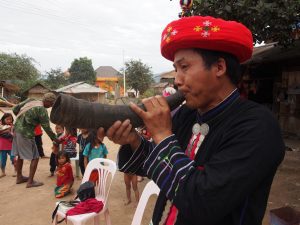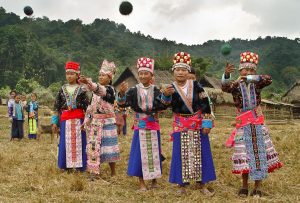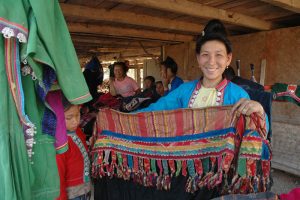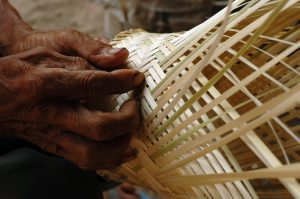No products in the cart.
Claiming Inspiration: Artisans, Culture, and Commercialisation
Claiming Inspiration: Artisans, Culture, and Commercialisation
ການຟື້ນຟູສິດທິ: ຊາວຊ່າງຫັດຖະກຳ, ວັດທະນະທຳ ແລະ ການຫັນເປັນທຸລະກິດ
ON DISPLAY NOW THROUGH AUTUMN 2025
The exhibition explores the boundary between cultural appropriation and artistic appreciation in the global fashion industry and sheds light on the growing field of Cultural Intellectual Property Rights. “Claiming Inspiration” is a collaboration between TAEC and the Oma, an ethnic minority community from the remote northern highlands of Laos with a total population of only 2,800 people. The impetus came when it was discovered that traditional Oma motifs and designs were copied by an Italian fashion house without consent or credit. Despite a global social media campaign, no wrongdoing was ever admitted.
The exhibition highlights how pervasive the problem is, as well as the complex and nebulous concepts of inspiration, appropriation and creative homage. Visitors can see stunning examples of handmade traditional pieces from Maasai, Otomí, and Transylvanian communities next to mock magazine spreads showing fashion brands copying the same designs. Along with an interactive display that includes video and digital resources, the exhibition raises compelling questions about the history of appropriation in the fashion industry and how to instead encourage creative collaboration.
Additionally, the exhibition provides examples of ethical collaborations between indigenous groups and fashion designers. These include Norma Baker-Flying Horse of Red Berry Woman and the Hidatsa tribe in the United States; Filip+Inna and the T’boli community in the Philippines; and Khang and the Krieng ethnic group in Laos.

“In this exhibition we wanted to highlight the richness and creativity of traditional knowledge and designs, and how they are just as deserving of legal protections and investment. “Traditional” can be “fashionable”, we just need to find a new design paradigm.” – Tara Gujadhur, TAEC Co-Director
There is currently no international legal framework obliging companies to seek consent from or to pay compensation to communities for their shared cultural knowledge. This is not only damaging to the cultural sustainability of these communities, but a risk to the economies of countries like Laos, with large handicraft sectors that are crucial to rural supplementary income generation, particularly for women. Visit our resource page to learn more about intellectual property rights for artisans in Laos and around the world.
The “Claiming Inspiration: Artisans, Culture, and Commercialisation” exhibition was supported by the European Union Delegation to the Lao PDR and Voice Laos, in partnership with the Cultural Intellectual Property Rights Initiative® (CIPRI). We would like to thank the Oma community for the trust they have placed in TAEC and for displaying their traditional designs in the final exhibition.

“When I first saw the exhibition, I was very excited to see and learn about the diversity of different ethnic groups, cultures of traditional clothing, and the same issues about their traditional designs. Traditional motifs are very important; our children must learn how to make and preserve them for the next generation.” – Ms. Onchanh, Oma artisan
“In the future if our parents pass away, the next generation will know we have documented Oma livelihoods, traditional clothes, and designs for them to learn and keep for the next generation.” – Mr. Khampheng, Oma Village Chief
Claiming Inspiration: Artisans, Culture, and Commercialisation ການຟື້ນຟູສິດທິ: ຊາວຊ່າງຫັດຖະກຳ, ວັດທະນະທຳ ແລະ ການຫັນເປັນທຸລະກິດ ON DISPLAY NOW THROUGH AUTUMN 2025 The exhibition explores the boundary between cultural appropriation and artistic appreciation in the global fashion industry and sheds light on the growing field of Cultural Intellectual Property Rights. “Claiming Inspiration” is a collaboration between TAEC and the Oma, […]




